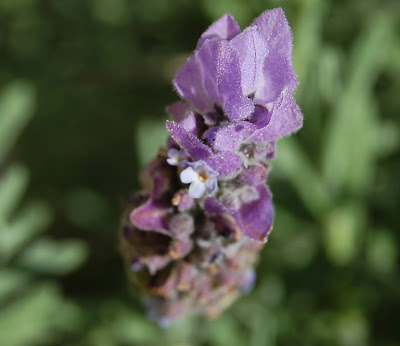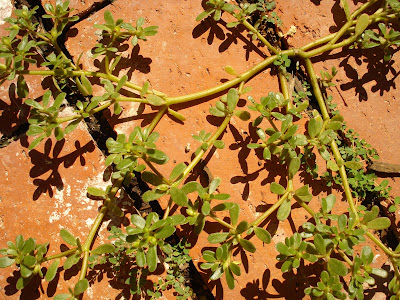this is what i have in the herb garden right now and then a brief basic description on how the herb can be used medicinally. they can be prepared in an infusion (steep in hot water for at least four hours) or for stronger medicine - a tincture (soaked in alcohol for 4-6 weeks).
what is that sentence i am supposed to say now ? something like: these statements have not been evaluated by the food & drug administration. they are not intended to diagnose, treat, cure or prevent any disease. consult with your health care practitioner for proper use. there.
thyme (Thymus vulgaris) - antiseptic properties - can be used as a mouthwash, skin cleanser, anti-fungal agent for athlete's foot and anti-parasitic for lice
sage (Salvia officinalis) - for mouth sores and sore throat. for sore throats, mix sage tea with apple cider vinegar and salt for gargling
lavender (Lavandula angustifolia) - a benefit for stress, anxiety, exhaustion, irritability, headaches, migraines, insomnia, depression
rosemary (Hyssopus officinalis) - a digestive aid. treats depression and headaches. use as an expectorant and for muscle spasms
marjoram (Origanum majorana) - relief from symptoms of hay fever, sinus congestion, indigestion, asthma, headache, dizziness, colds, coughs, and nervous disorders. marjoram essential oil has been one of my favorites for headaches - a few drops on forehead and temples
catnip (Nepeta cataria) - very mild herb medicinally. it has calming and sedative effects. which surprises me since cats go bonkers for this stuff !
parsley (Carum petroselinum) - a vitamin and mineral powerhouse. a natural breath sweetener. eat the leaves right off the plant to combat breath odors
feverfew (Tanacetum parthenium) - helps dramatically in some cases of migraine, arthritis pain, painful menstruation, rheumatism, and muscle spasms
lemon verbena (Aloysia triphylla or Lippia citriodora - confused on the latin name here) - relief of digestive tract spasms, reduction of fever, strengthening of the nervous system. has the ability to break down cellulite, and has a soothing, healing and toning effect on the skin
basil (Ocymum basilicum) - digestive and anti-gas properties. also for stomach cramps, vomiting, constipation, headaches, and anxiety
comfrey (Symphytum officinale) - a priceless herb for wounds, sprains, bruises
valerian (Valeriana officinalis) - a central nervous system relaxer and a sleep aid
common rue (Ruta Graveolens) - the leaves applied externally will ease the severe pain of sciatica and headaches
horehound (Marrubium vulgare) - benefits chronic cough and asthma
spearmint (Mentha spicata) - relieves hiccough and flatulence
chamomile (Matricaria chamomilla) - a remedy for hysterical and nervous affections in women (!) has a wonderfully soothing and sedating effect
calendula (Calendula officinalis) - a remedy for the pain and swelling caused by bee or wasp sting. a lotion from the flowers helps sprains and wounds


 i am reading a book by Pam Montgomery called Plant Spirit Healing and i am absolutely inspired. its about joining in a relationship with plants. so everyday i go out and spend time with lavender (Lavendula dentata). it's been a little difficult for me since i am not one to sit around. i am learning that it is a relationship that needs to be nurtured just like any other - spending time, caring. i sit there - i am absolutely giving myself up to this process. 'hello... i don't know what i am doing... but i came to visit again today'. and i sit. yesterday i went out with a magnifying glass and looked real close at the flowers and leaves - paying attention to details - i did notice differences in the newer and older leaves. the leaves of dentata are almost like little woven baskets. i touch the leaves - smell the leaves. i am looking at the environment it lives in - what it likes. it is in full sun - so that means its energy is active, stimulating, masculine, drying, outward. this lavender plant was one the first plants i put in the ground 13 years ago when i bought this house. a lot of plants have come and gone. this lavender has not. i took pictures of it - which actually helped me focus on the plant. i tasted it. i am learning the taste of a plant will help me understand the organ or system it helps in the human body. so for today - i just go out and sit with lavender.
i am reading a book by Pam Montgomery called Plant Spirit Healing and i am absolutely inspired. its about joining in a relationship with plants. so everyday i go out and spend time with lavender (Lavendula dentata). it's been a little difficult for me since i am not one to sit around. i am learning that it is a relationship that needs to be nurtured just like any other - spending time, caring. i sit there - i am absolutely giving myself up to this process. 'hello... i don't know what i am doing... but i came to visit again today'. and i sit. yesterday i went out with a magnifying glass and looked real close at the flowers and leaves - paying attention to details - i did notice differences in the newer and older leaves. the leaves of dentata are almost like little woven baskets. i touch the leaves - smell the leaves. i am looking at the environment it lives in - what it likes. it is in full sun - so that means its energy is active, stimulating, masculine, drying, outward. this lavender plant was one the first plants i put in the ground 13 years ago when i bought this house. a lot of plants have come and gone. this lavender has not. i took pictures of it - which actually helped me focus on the plant. i tasted it. i am learning the taste of a plant will help me understand the organ or system it helps in the human body. so for today - i just go out and sit with lavender.















































